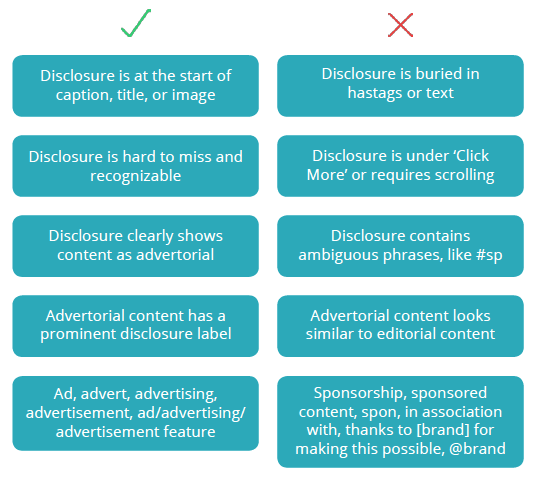To avoid misleading consumers, brands and creators must be transparent with their collaborations. Consumers may find it difficult to differentiate between advertorial content (sponsored content) and editorial content (non-commercial content). In order to protect consumers from unfair advertising practices, it’s important that brands and creators are upfront about their partnerships. They should follow disclosure guidelines and include a disclosure along with their sponsored content.
Disclosure guidelines differ from country to country. We’ve outlined guidelines on how to disclose properly for the United Kingdom and United States. You can also find out how to disclose sponsored content in the Nordics (Norway, Sweden, Finland). These guidelines are up to date as of 22 August 2022.
Regulations by country:
Jump to the United Kingdom
Jump to the United States
Table of Contents
The United Kingdom
What are the disclosure guidelines?
The Committee of Advertising Practice (CAP) and the Advertising Standards Authority (ASA) monitors advertising practices in the UK. The guidelines state that it’s against the law for creators to publish a post promoting a product where they’ve been paid, but it’s not clear that the post is an ad. This is the case whether the post is “in the form of a blog, vlog, tweet, post, or other channel-specific format.” Creators who fail to disclose the ‘commercial intent’ behind a post falsely misrepresent themselves as consumers.
The Competition and Markets Authority (CMA) is also involved in setting rules and regulations, but works more to ensure that consumers get a good deal when buying goods and services, and that businesses operate within the law.
What’s an ad?
- Paid-for space: An advertiser pays for an ad to appear in a ‘paid-for ad space,’ like a sponsored post on social media.
- Own advertising: Creators post about their own products/services on their personal social media channels.
- Affiliate marketing: Creators share an affiliate link or discount code with a post and get paid per click or sale.
What’s counts as an ad?
According to CAP, content on social media is considered an ad if:
- The brand has paid a creator, and
- The brand had some editorial control over the content the creator produces.
If creators receive a form of payment, and the brand doesn’t have editorial control, the consumer protection legislation still applies and is enforced by the CMA.
In short, if there’s any uncertainty about disclosing, it’s safer to disclose. Learn more here and here.
What’s considered payment?
- Monetary payment
- Commission (ie: affiliate marketing)
- Loaned products or services
- Free products or services, whether requested or given unexpectedly
- Any other incentive
If brands and creators have ‘commercial relationships’ (ie: brand ambassadors), this is also considered payment.
If creators promote their own products or services on their social media, they’ll need to make it clear that it’s their own line of products or services. If that’s clear, consumers are typically able to realize that creators are promoting their own brand.
What’s editorial control?
If brands can control any aspect of their collaboration with creators, they likely have editorial control. According to the ASA: “as a rule of thumb, if [creators] weren’t completely free to do and say whatever [they] wanted whenever they wanted, then there could have been some level of editorial control by the brand.”
For example, brands have editorial control if they:
- Tell creators what they need to say. This includes certain words, phrases, key messages you need to convey, or hashtags.
- Tell creators what needs to be in the content. This can include a specific action or type of content.
- Ask to approve content before creators post it, or have asked them to edit it.
- Require a number of posts that need to be shared at specific dates or times.
- Could request changes to the content, and the creator would have to carry them out.
How can ads be clearly shown as ads?
The ads “must be obviously identifiable as such.” To ensure sponsored content is perceived as an ad, it’s important that creators include a clear disclosure with the content. Consumers should be able to see that the content is an ad immediately, and shouldn’t have to do additional work to figure that out.

The rules apply to any social media channel you’re using, whether it’s Facebook, TikTok, Instagram, Twitter, Snapchat, or YouTube. Both the ASA and CMA advise using labels like “Ad”, “Advert”, “Advertisement”, or “Advertisement Feature”. They recommend including this disclosure at the very beginning of a post, in a title or thumbnail, or on an image (if that’s all people see at first).
Anything else you should know?
Be sure to review the CAP Code to ensure the ads are following the law, especially in situations where the ad:
- Makes any claims about a product. Read more here.
- Promotes products or service that have an age limit, such as alcohol or gambling.
- Sponsors products that have many regulations, such as food and supplements.
- Runs giveaways. Read more here.
You can learn more about disclosures here.
The United States
What are the disclosure guidelines?
The Federal Trade Commission (FTC), which monitors advertising practices in the US, requires that ads are clear and easily identifiable by creators’ audience. To do this, it’s important that creators include a disclosure with their sponsored content.

Other things that should be considered to ensure consumers can easily identify sponsored content:
- If the creators’ website is long, disclosures should be repeated.
- If they share a sponsored video, the disclosure should remain long enough on the screen to be read. It should also be spoken audibly so it can be heard and understood.
- Creators should be considerate of technological limitations. For example, their audience may not allow pop-ups, so pop-up disclosures might not be seen.
- If creators share a sponsored blog post on Twitter, your blog post and tweet should both include a disclosure.
It’s important that creators and brands don’t assume disclosures provided by social media platforms, such as Instagram’s Paid Partnership tag, are sufficient enough to meet the disclosure guidelines outlined by the FTC. To be sure sponsored content have proper disclosures, it’s best that creators include a disclosure in their captions in addition to using the Paid Partnership tag.
You can review more of the disclosure policies here.
Disclaimer: This post is meant to provide you with guidelines on how you can avoid breaking marketing laws and regulations, and it should not be considered legal advice. If you’re unsure about how to disclose, we recommend that you reach out to the consumer authority in your country.
inzpire.me
inzpire.me is an influencer marketing platform that connects brands with creators across the globe. Ready to launch a campaign? Schedule a call today!










